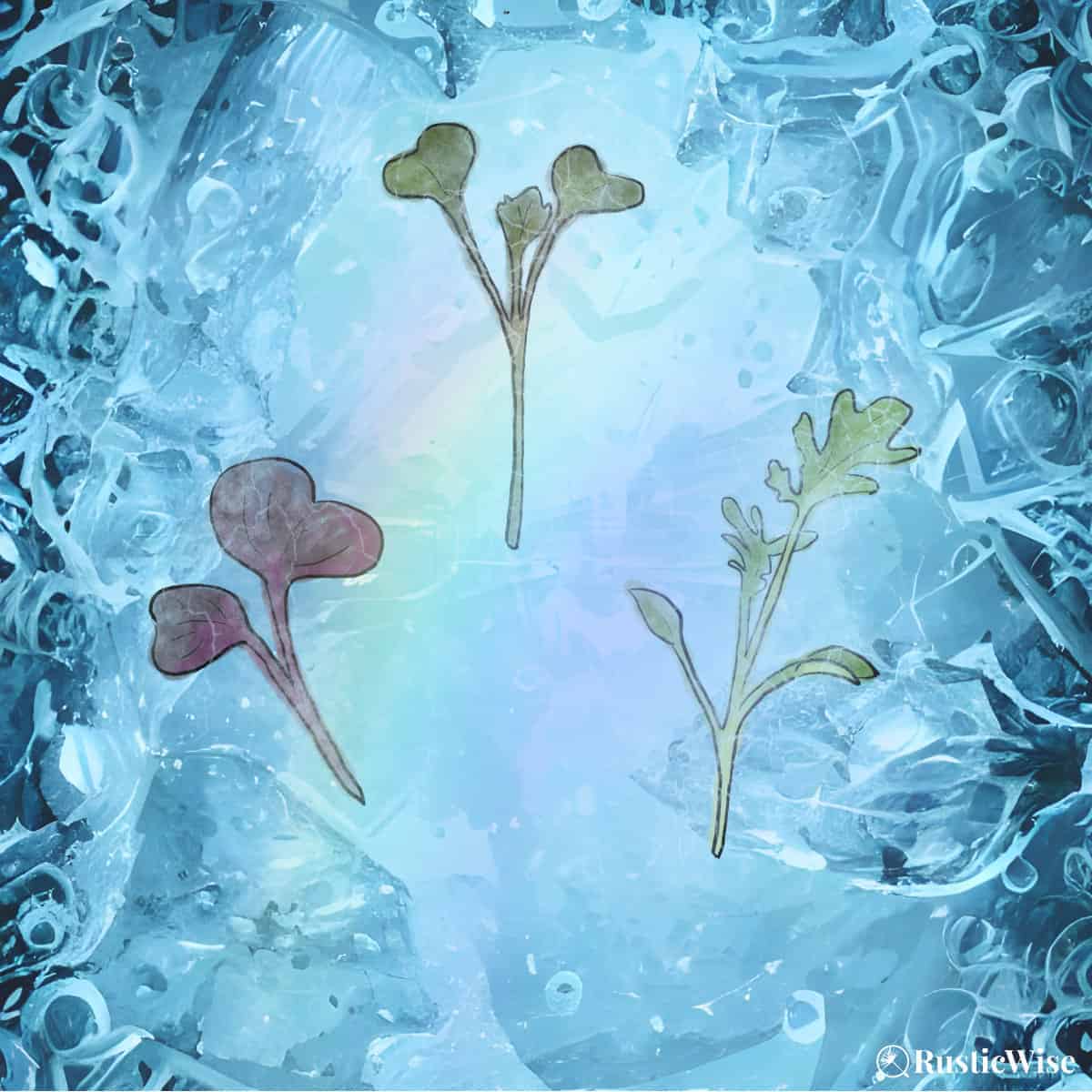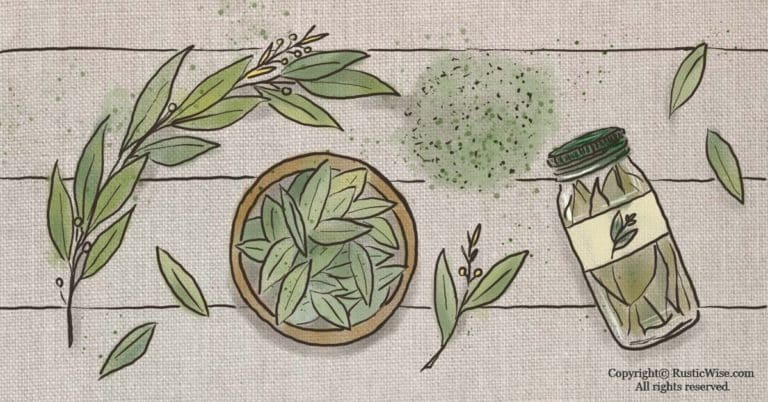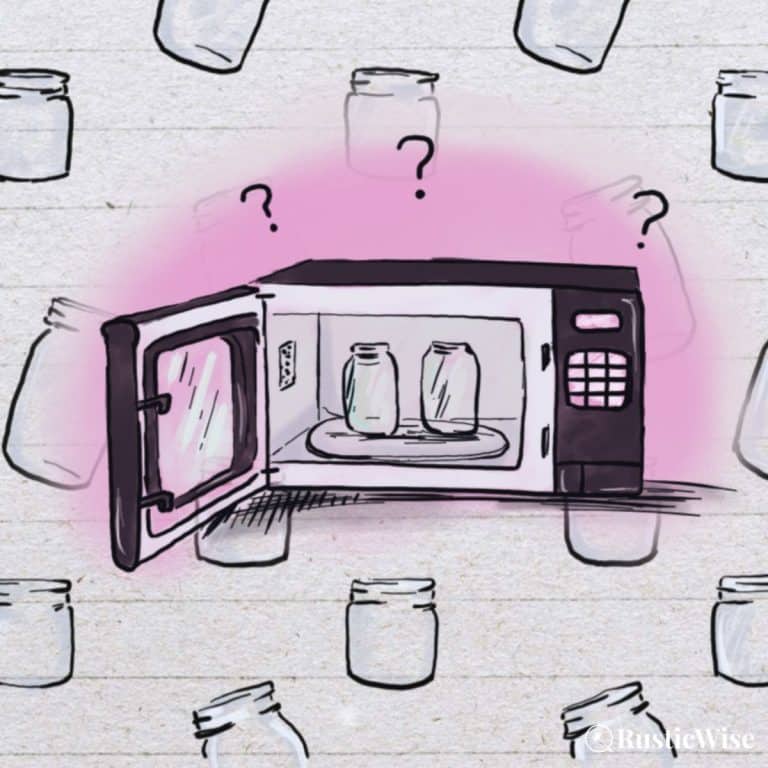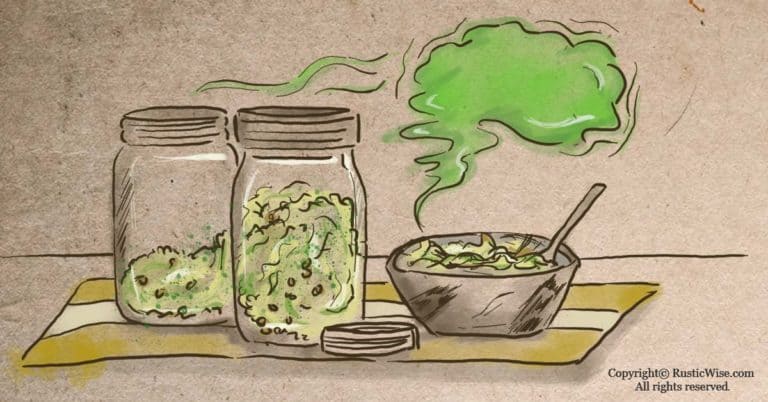Can Microgreens Be Frozen? Yes, but Here’s a Better Way To Preserve Them
Have an abundance of microgreens? Whether your trays are all ready to harvest at once, or you went a little overboard at the farmer’s market, there are ways to extend the shelf life of microgreens.
Can microgreens be frozen? Yes, technically you can freeze these tiny greens. But similar to lettuce, micros don’t freeze well. When frozen, the cell walls of the plants rupture, resulting in a noticeable change in texture, flavor, and sometimes color. A better way to preserve microgreens is to dehydrate them and grind them to a powder for smoothies or juices.
Food waste is a big problem in most of the western world. Let’s look at how to freeze microgreens (if you really need to), and how to best use frozen micros. Plus, we’ll look at how you can dehydrate microgreens using an electric dehydrator or an oven.
What happens when you freeze vegetables (and microgreens)?
Water makes up the bulk of most vegetables and fruit. Roughly 90 percent of their weight is water content.¹
In their raw, unfrozen state, vegetables and microgreens hold water and minerals in rigid cell walls. These rigid or semi-rigid cell walls give produce their shape.
When you freeze something, the water within the cells turns to ice crystals. The ice expands and causes the cell walls to rupture. This rupturing causes significant changes to a food’s texture—many thawed foods have a mushier texture.
And some foods like lettuce, or micros simply don’t freeze well.
Before freezing most types of vegetables, general guidelines are to blanch them quickly (dip them into boiling water) to halt enzyme activity and extend shelf life. This is how you freeze squash, broccoli, and even spinach.
But the delicate nature of microgreens means they don’t withstand high heat very well. They’ll wilt and wither.

Can microgreens be frozen? Yes, but here’s what you need to know
Yes, you can freeze fresh microgreens if you’re in a pinch. But the fragile cell structure of these tiny greens doesn’t freeze well.
Let’s be clear—microgreens taste best (and have the most nutrients) when they are fresh.
If you have no other choice but to freeze them, don’t defrost micros. The thawing process will turn them into a mushy mess!
Instead, keep them in their frozen state and get creative with micros. They make a great addition to any smoothie or healthy juice. Just grab a small handful from the freezer and blend or juice them.
How to freeze your microgreens
If you’ve ever frozen food only to have it turn into a big block of impenetrable ice, you’ll know that this is NOT what you want to happen to your precious micros.
The aim here is to freeze them in useable chunks.
- Wash: Give your harvested microgreens a quick rinse under cool water to remove any dirt or debris.
- Dry: Use a salad spinner to remove excess moisture. Or, place the microgreens between two sheets of paper towel, or a clean cotton drying cloth and pat dry. Wet microgreens will cause crystals to form so you’ll want to remove as much water as possible.
- Cut (optional): Larger greens, such as pea shoots or sunflower microgreens, could benefit from cutting into smaller pieces before freezing. This step is optional, however.
- Lay flat and freeze: Use a baking sheet to spread out the microgreens into a thin layer. Place in the freezer for 1 to 2 hours, or until frozen. While it’s almost impossible to freeze them individually, the purpose is to freeze them into manageable chunks.
- Package and label: Gather your frozen goods into freezer-safe airtight containers or freezer bags. Don’t forget to label them with the type of microgreen and the date! Stack them in the freezer.
How long do frozen microgreens last?
Frozen microgreens will last up to a year but are best used within 6 months.
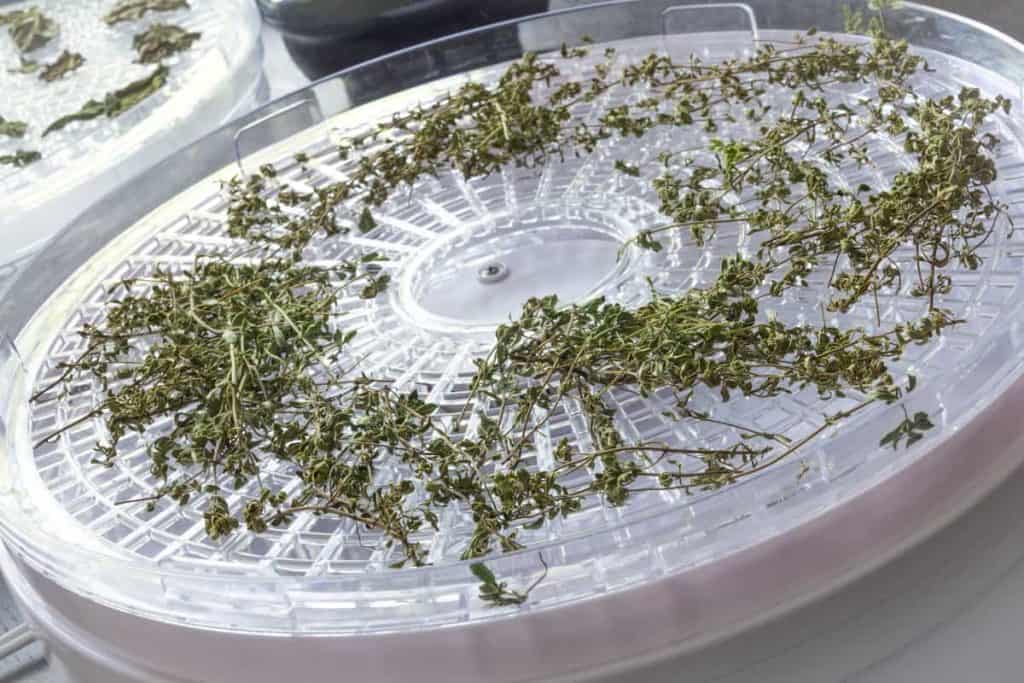
Credit: Deposit Photos
How to dehydrate or dry microgreens
Dehydrating is a quick and easy way to make foods last longer. Drying micros is a great way to enjoy their flavor and nutritional benefits at your leisure. Making dehydrated microgreens takes a bit of time, but the extra work is well worth it!
When exposed to a constant temperature, excess moisture in foods is reduced to prolong shelf life.
The best way to dry out a batch of microgreens completely is to use an electric food dehydrator. If you don’t have one of these, no worries. I’ll also show you how to use a conventional oven.
How to dry microgreens using a dehydrator
The low steady heat and ventilation system of an electric dehydrator makes this a mostly hands-off job.
- Wash: Give your harvested greens a quick rinse under cool water to remove any dirt or debris.
- Dry: Use a salad spinner to remove excess water. Or, place the microgreens between two sheets of paper towel, or a clean cotton drying cloth and pat dry. Wet microgreens will bump up drying time.
- Arrange on trays: Lay the microgreens on the trays, spacing them out to ensure they have plenty of ventilation. Set the temperature to between 115 to 130 degrees Fahrenheit (46 to 54 degrees Celsius).²
- Check for doneness: Depending on the household humidity, moisture on the micros, and the size of the batch you’re drying, it can take several hours to fully dry. You’ll know the microgreens are done when they are brittle to the touch. If not done, continue drying for another 15 to 30 minutes.
How to dry microgreens using a regular oven
Using a conventional oven to dehydrate foods requires more checking. You want to set your conventional oven to the lowest temperature setting as high heat will scorch those delicate greens.
After washing and drying the greens, lay them on a baking sheet in a thin layer with plenty of space between each.
Check your microgreens every 30 minutes and turn/rotate the greens and trays each time to promote even heating.
The microgreens will be brittle to the touch when completely dried. It’s better to over-dry than to under-dry. When in doubt, tack on an extra 15–30 minutes.
How to store microgreens after dehydration
Once they are completely dry, put them in airtight containers or bags in a dark, cool place.
The best way to store your microgreens is in an area away from direct sunlight or a heat source. Keeping your dried microgreens in a cupboard by the stove or oven is a no-no if it gets hot. Keep it in the pantry or a cupboard away from heat.
Dried microgreens may last up to 1 year with proper storage.
Whole or ground?
You can leave them whole, but you might find it’s handier to make a microgreens powder instead. You can grind up the dried greens using a mortar and pestle.
Ways to eat microgreens
If you have a huge batch of microgreens to eat up, there are so many ways to enjoy them. To use microgreens as part of a healthy and tasty dish, you’re limited only by your imagination.
Tip: Keep your microgreens fresh in the fridge where the cold temperature will extend shelf life. Store them loosely wrapped in a plastic bag or container in the crisper section. To prolong the shelf life of your microgreens, they need some airflow and humidity so airtight containers can actually shorten their lifespan.

Credit: Augustine Fou / Unsplash
Raw microgreens
The preferred way to eat micros is when they’re fresh and raw. When eaten raw, you’ll get the most nutrients from this superfood.
- Try adding them as part of a salad mix. Radish microgreens add a spicy kick, while sunflower microgreens are nutty and sweet.
- Add to sandwiches and wraps.
- Use as a garnish for savory dishes.
- Add to omelets and soups.
- Add a handful of micros for smoothies or juices.
Lightly cooked
Cooking microgreens is a little tricky as they wilt quickly. When you cook micros, they lose a bit of their nutritional value. To cook micros, rinse them briefly, and pat dry.
Some varieties of micros will stand up to heat better, such as pea shoots, which are larger and more substantial. Plus, they taste like sweet peas, which makes them great for stir-fry!
Cook them by sautéing with a bit of oil and some salt over low heat. Do not overcook them! They cook quickly. To avoid overdone microgreens, start with the lowest possible heat and be sure to flip them often.
If you want to use your micros in light dishes, such as pasta sauce, or other dishes as a garnish, then it’s best to cook them as little as possible. Add your micros during the last minute or two of cooking.
Ways to use dehydrated microgreens
Micros have a wide variety of flavors that can be used in a vast array of dishes. You’ll get the benefits of microgreens in a small amount, so avoid overdoing it.
- Add a pinch of micro powder to flavor soups, stews, and casseroles. You can add a spicy dimension with just a bit of radish or mustard greens.
- Make healthier dips by mixing in a pinch of dried microgreens.
- Add in a small spoonful of powdered micros to healthy smoothies and juices.
👉 If you like this post, see our Complete Guide to Growing Microgreens at Home. 🌱
Would you like more timeless tips via email?
Fun tips to help you live an independent, self-sustaining lifestyle. Opt-out at any time.


References
- University of Minnesota Extension, The science of freezing foods, https://extension.umn.edu/preserving-and-preparing/science-freezing-foods. Accessed November 2022.
- University of Missouri Extension, Introduction to Food Dehydration, https://extension.missouri.edu/publications/gh1562. Accessed November 2022.

Author: Theresa Tesolin
Theresa is co-founder of RusticWise. She helps people unleash their inner DIY spirit by encouraging them to get dirty and make or grow something from scratch.

